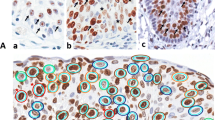Summary
We investigated whether two parameters of proliferative activity — mitotic rate and Ki-67 positive cells — are interchangeable. The mitotic rate was assessed on paraffin-embedded sections, Ki-67 positive cells were immunohistologically determined in frozen tissue. A poor correlation (correlation coefficient r=0.57) was found between both parameters. The proliferative activity was often not homogeneously distributed in the tested tumors. However, this is a major reason for the observed difference only in thin melanomas (<1.5 mm) as seen by comparison of tumors with homogeneous and inhomogeneous proliferative activity. We assume that arrest of cells in different stages of the cell cycle — variable from melanoma to melanoma — is the major reason for the observed discrepancy between mitotic rate and Ki-67 positive cells in tumors of 1.5 mm and thicker. The mean number of Ki-67 positive cells increased with tumor thickness. The stability of the Ki-67 antigen towards freezing, thawing, and formalin was studied.
Similar content being viewed by others
References
Barlogie B, Latreille J, Freireich EJ, Fu C-T, Mellard D, Meistrich M, Andreeff M (1980) Characterization of haematologic malignancies by flow cytometry. Blood Cells 6:719
Bradford Hill A (1974) Principles of medical statistics, 9th edn. The Lancet Ltd, London
Braun N, Papadopoulos T, Müller-Hermelink HK (1988) Cell-cycle dependent distribution of the proliferation-associated Ki-67-antigen in human embryonic lung cells. Virchows Archiv/B (Cell Pathol) 56:25–33
Brock WA, Schwartzendruber DE, Grdina DJ (1982) Kinetic heterogeneity in density-separated murine fibrosarcoma subpopulations. Cancer Res 42:4999–5003
Buser MW, Oberholzer M, Christen H, Heitz PU (1987) Analysis of object clustering. Anal Quant Cytol Histol 9:303–314
Cordell JL, Falini B, Erber WN, Ghosh AK, Abdulaziz Z, MacDonald S, Pulford KAF, Stein H, Mason DY (1984) Immunoenzymatic labeling of monoclonal antibodies using immune complexes of alkaline phosphatase and monoclonal anti-alkaline phosphatase (APAAP complexes). J Histochem Cytochem 32:219–229
Day CL, Mihm MC, Lew RA, Harris MN, Kopf AW, Fitzpatrick TB, Harrist TJ, Colomb FM, Postel A, Hennessey P, Gumport SL, Raker JW, Malt RA, Cosimi AB, Wood WC, Roses DF, Gorstein F, Rigel D, Friedman RJ, Mintzis MM, Sober AJ (1982) Prognostic factors for patients with clinical stage I melanoma of intermediate thickness (1.51–3.99 mm). Ann Surg 195:35–43
Drewinko B, Yang LY, Barlogie B, Trujillo JM (1984) Cultured human tumour cells may be arrested in all stages of the cycle during stationary phase: demonstration of quiescent cells in G1, S, and G2 phase. Cell Tissue Kinet 17:453–463
Gatter KC, Dunnill MS, Gerdes J, Stein H, Mason DY (1986) New approach to assessing lung tumours in man. J Clin Pathol 39:590–593
Gelfant S (1977) A new concept of tissue and tumor cell proliferation. Cancer Res 37:3845–3862
Gerdes J, Schwab U, Lemke H, Stein H (1983) Production of a mouse monoclonal antibody reactive with a human nuclear antigen associated with cell proliferation. Int J Cancer 31:13
Gerdes J, Dallenbach F, Lennert K, Lemke H, Stein H (1984) Growth fractions in malignant non Hodgkin's lymphomas (NHL) as determined in situ with the monoclonal antibody Ki-67. Hematol Oncol 2:365–371
Gerdes J, Lemke H, Baisch H, Wacker H-H, Schwab U, Stein H (1984) Cell cycle analysis of a cell proliferation-associated human nuclear antigen defined by the monoclonal antibody Ki-67. J Immunol 133:1710–1715
Gerdes J, Lelle RJ, Pickartz H, Heidenreich N, Schwarting R, Kurtsiefer L, Stauch G, Stein H (1986) Growth fractions in breast cancers determined in situ with the monoclonal antibody Ki-67. J Clin Pathol 39:977–980
Gotzos V, Cappelli-Gotzos B, Petropoulos P, Conti G (1986) Sur le cycle prolifératif des cellules tumorales metastatisées dans les épanchements pleuraux et abdominaux chez l'homme (Etude de 25 cas). Cell Mol Biol 32:201–218
Gray JW, Dolbeare F, Pallavicini MG, Vanderlaan M (1986) Flow cytokinetics. In: Gray JE, Darzynkiewicz Z (eds) Techniques in cell cycle analysis. Humana Press Clifton, New Jersey, pp 93–137
Kuehnl-Petzoldt C, Keil H, Schoepf E (1984) Prognostic significance of the patient's sex, tumor site and mitotic rate in thin (≤1.5 mm) melanoma. Arch Dermatol Res 276:151–155
Pierard GE, Pierard-Franchimont C, Henry C, Lapiere M (1984) The proliferative activity of cells of malignant melanomas. Am J Dermatopathol 6 [Suppl 1]:317–323
Sachs L (1978) Angewandte Statistik, 5. Aufl. Springer, Berlin Heidelberg New York
Schmoeckel C, Braun-Falco O (1978) Prognostic index in malignant melanoma. Arch Dermatol 114:871–873
Sober AJ, Day CL, Fitzpatrick TB, Lew RA, Kopf AW, Mihm MC (1983) Factors associated with death from melanoma from 2 to 5 years following diagnosis in clinical stage I patients. J Invest Dermatol 80:53–55
Walker RA, Camplejohn RS (1988) Comparison of monoclonal antibody Ki-67 reactivity with grade and DNA flow cytometry of breast carcinomas. Br J Cancer 57:281–283
Author information
Authors and Affiliations
Rights and permissions
About this article
Cite this article
Ostmeier, H., Suter, L. The Ki-67 antigen in primary human melanomas —its relationship to mitotic rate and tumor thickness and its stability. Arch Dermatol Res 281, 173–177 (1989). https://doi.org/10.1007/BF00456388
Received:
Issue Date:
DOI: https://doi.org/10.1007/BF00456388




